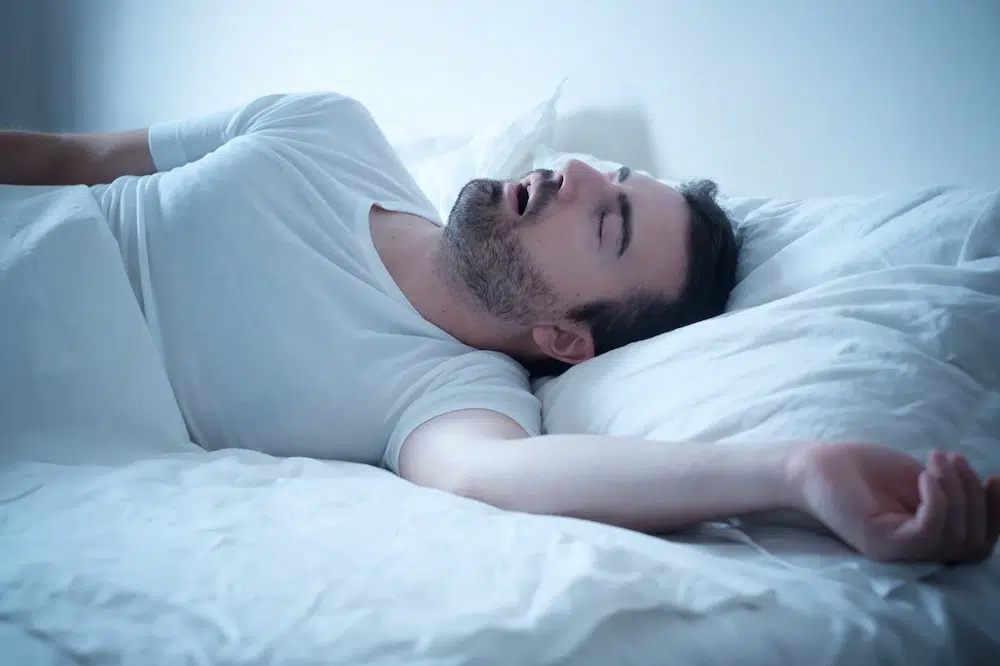
What Is Severe OSA – Must-Know Facts
We all expect our sleeping to be easy, right? But for many, it’s a time of hidden struggle, all because of a condition called Obstructive Sleep Apnea (OSA).
OSA means a person’s breathing stops and starts while they’re asleep. It’s like trying to sleep while someone randomly covers your nose and mouth! Many people have this problem, which affects their health and safety.
The most intense form of this issue? Severe OSA. In this article, we’ll dive into What is Severe OSA, uncovering the deeper layers of this sneaky sleep stealer.
Understanding Obstructive Sleep Apnea
Normal Breathing During Sleep
When you sleep, your body relaxes. This includes the muscles in your throat. Yet, in most people, this relaxation doesn’t cause any problems.
The air moves freely in and out of the lungs as they sleep. This means they get enough oxygen and release carbon dioxide.
Causes And Mechanisms Of Obstructive Sleep Apnea (OSA)
1. Muscle Relaxation:
Sometimes the muscles at the back of your throat relax too much. This makes the airway close or get really narrow.
2. Tongue And Tonsils:
For some, their tongue and tonsils are big compared to the airway. They can block the airflow, if they fall back during sleep.
3. Airway Shape:
Some people have a naturally narrow throat. It can close easily.
4. Weight:
People who carry extra weight, especially around their necks usually have a smaller airway. This makes blockage more likely.
5. Brain Signals:
Sometimes the brain doesn’t send the right signals to keep the throat muscles stiff. This causes a blockage.
When the airway gets blocked, you can’t breathe in oxygen or breathe out carbon dioxide well. This makes the oxygen level in the blood drop.
Your brain senses this and wakes you up briefly so you can breathe. This happens many times in one night but you can not even remember it.
Differentiating Between Mild, Moderate, And Severe OSA
Mild OSA:
- 5 to 15 events in an hour.
- An “event” is a pause in breathing or shallow breathing.
- Will cause daytime tiredness, but not everyone notices.
Moderate OSA:
- 15 to 30 events in an hour.
- More pronounced daytime sleepiness.
- Difficult to stay awake during quiet activities, such as reading or watching TV.
Severe OSA:
- More than 30 events in an hour.
- Strong daytime sleepiness.
- Difficulty staying awake even during active tasks, like talking or driving.
Identifying Severe OSA
Definition Of Severe OSA
Severe Obstructive Sleep Apnea (OSA): A sleep disorder characterized by more than 30 events of paused or shallow breathing in an hour of sleep.
These interruptions can decrease the oxygen levels in the blood, causing brief awakenings throughout the night.
Common Symptoms And Warning Signs Of Severe OSA
Loud Snoring:
Often disruptive and can be heard in multiple rooms.
Choking Or Gasping:
These sounds can occur when breathing restarts after an “event” or pause.
Frequent Awakenings:
Many brief awakenings throughout the night, which the person will not remember.
Daytime Fatigue:
Feeling extremely tired or falling asleep during activities, even driving.
Morning Headaches:
Due to low oxygen levels or disrupted sleep.
High Blood Pressure:
OSA can lead to or worsen hypertension.
Dry Mouth Or Sore Throat Upon Waking:
This can be due to breathing through the mouth during sleep.
Importance Of Seeking Medical Evaluation And Diagnosis
Health Risks:
Severe OSA can increase the risk of heart disease, stroke, diabetes, and other serious health conditions.
Daily Life Impact:
Poor sleep quality can affect job performance, relationships, and overall quality of life.
Accidents:
Daytime fatigue can increase the risk of car and workplace accidents
Treatable Condition:
With diagnosis, treatments like CPAP (Continuous Positive Airway Pressure) machines, lifestyle changes, or surgeries can help.
Prevention:
Early diagnosis and treatment can prevent or alleviate associated health issues.
Risk Factors For Severe OSA
Obesity And Its Association With Severe OSA
A significant link exists between obesity and severe OSA. Excess weight, especially around the neck area, can constrict the airway, making it more susceptible to obstruction during sleep.
Fat deposits around the upper airway can obstruct breathing, and as the body mass index (BMI) rises, the chances of experiencing OSA also increase.
It’s not uncommon for individuals to see an improvement in OSA symptoms after losing weight.
Age And Gender As Risk Factors
Both age and gender play essential roles in the likelihood of developing severe OSA.
While OSA can occur at any age, the risk generally increases as one gets older, due to the natural loss of muscle tone in the throat over time.
Men, particularly middle-aged ones, are more likely to suffer from OSA than women.
However, the gender gap diminishes with age, and post-menopausal women become more at risk, almost matching the rates seen in men.
Other Medical Conditions That May Contribute To The Severity Of OSA
- Congestive Heart Failure: Increases OSA risk.
- High Blood Pressure: Often linked to OSA.
- Polycystic Ovary Syndrome: Can enhance OSA likelihood.
- History of Strokes or Brain Tumors: Raises OSA risk.
- Family History of OSA: Indicates potential genetic predisposition.
- Asthma: Can temporarily increase OSA risk.
- Respiratory Infections: Potential to briefly heighten OSA risk.
Complications And Health Implications Of Severe OSA
Impact On Cardiovascular Health
Severe OSA can lead to heart problems. Paused breathing causes blood oxygen drops, increasing blood pressure and the risk of conditions like heart attacks and irregular heart rhythms.
Cognitive And Psychological Consequences
Severe OSA interrupts sleep, affecting brain function. This can cause memory and concentration issues that lead to mood disorders such as depression and anxiety.
Daytime Fatigue And Increased Accident Risks
Continuous sleep interruptions from OSA cause daytime drowsiness, affecting focus and increasing the risk of accidents, including dangerous driving situations.
Relationship Between Severe OSA And Metabolic Disorders
Severe OSA is linked to insulin resistance, raising the risk of type 2 diabetes. Sleep disruptions can also lead to weight gain, which in turn can worsen OSA.
Diagnostic Procedures For Severe OSA
Polysomnography As The Gold Standard For Diagnosis
Polysomnography, commonly referred to as a sleep study, is the most comprehensive test for diagnosing OSA.
Conducted in a sleep center, it tracks brain activity, eye movement, heart rate, blood oxygen levels, and breathing patterns as a person sleeps.
This in-depth analysis provides a clear picture of how many breathing disruptions occur in an hour, confirming the presence and severity of OSA.
Other Diagnostic Methods And Portable Sleep Monitoring Devices
Home Sleep Apnea Tests (HSATs):
- Portable devices used at home.
- Measure airflow, blood oxygen levels, and breathing patterns.
- Offer a convenient alternative to in-lab studies.
Oximetry:
- Measures oxygen levels in the blood.
- Often used as a preliminary test; if results indicate OSA, a full sleep study will be recommended.
Actigraphy:
- Wrist-worn device that detects sleep patterns based on movement.
- Useful for detecting insomnia or circadian rhythm disorders but can also provide insights into sleep quality related to OSA.
Treatment Options For Severe OSA
Lifestyle Changes And Weight Management
Losing excess weight can significantly alleviate OSA symptoms. Even a modest weight reduction can open up the throat and improve sleep patterns.
Avoiding alcohol, quitting smoking, and sleeping on one’s side can also help.
Continuous Positive Airway Pressure (CPAP) Therapy
CPAP is a commonly prescribed treatment for severe OSA. It involves wearing a mask over the nose and/or mouth during sleep.
The device provides a continuous airflow that keeps the airway open, ensuring uninterrupted breathing.
Bilevel Positive Airway Pressure (BiPAP) Therapy
BiPAP is similar to CPAP but offers two pressure settings: one for inhalation and a lower one for exhalation.
It’s often used for patients who find it difficult to exhale against the continuous pressure of CPAP.
Oral Appliances And Their Role In Treating Severe OSA
Oral appliances, or mandibular advancement devices, are designed to reposition the lower jaw and tongue to keep the airway open.
They are often used for milder cases but can be an option if a patient finds CPAP uncomfortable.
Surgical Interventions For Severe Cases
Surgery will be considered when other treatments are ineffective or inappropriate.
Procedures can range from removing excess tissue from the throat, correcting structural abnormalities, to more complex surgeries like jaw repositioning or a tracheostomy for extreme cases.
Adherence To Treatment And Long Term Management
Challenges With CPAP Therapy Adherence
- Discomfort with the mask or straps.
- Noise from the machine disturbing sleep.
- Dryness or congestion in the nose or throat.
- Initial feelings of claustrophobia.
Importance Of Follow-Up Appointments And Adjustments
- Ensures the treatment is effective.
- Allows for equipment checks and updates.
- Addresses any discomfort or side effects.
- Provides an opportunity to adjust pressure settings if needed.
Incorporating The Treatment Plan Into Daily Life
- Making CPAP/BiPAP a bedtime routine.
- Regular cleaning and maintenance of devices.
- Seeking support groups or counseling for motivation.
- Educating friends and family to understand and support the treatment process.
FAQs
1. What Causes Severe OSA?
Severe OSA is primarily caused by the relaxation of throat muscles, obstructing airflow during sleep. Factors like obesity, neck circumference, narrowed airway, and family history can increase its risk.
2. How Serious Is Severe OSA?
Severe OSA is highly serious. It can lead to cardiovascular problems, daytime fatigue, cognitive disturbances, and an increased risk of accidents. It requires prompt medical attention.
3. What Is Mild Vs Severe OSA?
Mild OSA involves 5 to 15 breathing disruptions per hour of sleep. Severe OSA exceeds 30 disruptions per hour, presenting more intense symptoms and health risks.
Conclusion
Sleep is a sanctuary for many of us, a time to rest and recharge. But for those grappling with Severe OSA nights can be more like a storm than a peaceful lullaby.
Remember, Severe OSA isn’t just loud snoring or a small hiccup in breathing; it’s a serious condition that can affect every aspect of life.
It’s crucial to be informed, seek help if needed, and remember that everyone deserves a good night’s sleep.
By understanding What is Severe OSA, we can shed light on this nighttime challenge and help many find the rest they deeply need.



